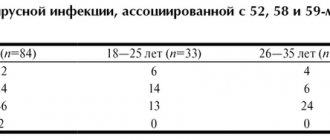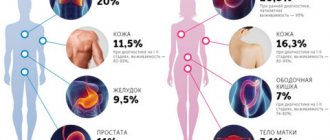Today, HPV infection is one of the most common and important STIs (predominantly sexually transmitted infections), which affects most of the sexually active population of the planet. The peak incidence of HPV infection occurs at the age of 18-25 years and decreases after 30 years, when the incidence of dysplasia and cervical cancer increases significantly, the peak of which occurs at 45 years.
The International Center for Health Protection carries out diagnosis of infection with the human papillomavirus, as well as procedures for the prevention of infection with sexually transmitted infections after casual sexual intercourse. All services of the gynecological department and prices for them can be found in the relevant sections of the site.
At least 50% of sexually active adults are infected with one or more types of HPV, and in most cases, genital HPV infection in them is unrecognized, subclinical or asymptomatic. Genital HPV infection is highly contagious and is acquired during the first few sexual contacts; Infection with a single sexual contact occurs in approximately 60% of cases.
Risk factors for human papillomavirus infection
Recent studies have established that HPV is a necessary but not sufficient factor in cervical neoplasia. Risk cofactors for the development of the disease may be:
- disorders of cellular and humoral immunity
- unfavorable socio-economic status;
- sexual behavior;
- concomitant sexually transmitted diseases (herpes, chlamydia, trichomoniasis, gonorrhea, syphilis, etc.);
- hypo- and vitamin deficiencies;
- young age;
- smoking;
- pregnancy;
- vaginal dysbiosis.
The virus is also sometimes transmitted from mother to child, both in utero and during childbirth. In addition, pregnancy is a provoking factor for the manifestation and growth of neoplasms, as well as their transition to cancer. This occurs due to a decrease in immune defense and changes in hormonal levels.
Quite often we have to deal with a situation where a patient is diagnosed with human papillomavirus (HPV) of high oncogenic risk. As a rule, doctors immediately inform you that there is a risk of developing cervical cancer. Often quite aggressive treatment is immediately prescribed, a biopsy is performed, however, in general, what is actually happening and what the further prognosis is is not clearly explained. So, if you have been diagnosed with a high oncogenic risk human papillomavirus (HPV) by PCR, this does not mean that you need to panic. There is nothing serious about this find; it is just a reason to undergo an appropriate examination.
Cervical screening, aimed at identifying oncologically dangerous human papillomavirus infection and associated lesions of the cervix, continues to be a necessary component of healthcare and every woman should remember the need to “undergo” it.
Identification of the causative agent of papillomavirus infection (Human Papillomavirus), during which the DNA of viruses in a sample of biomaterial is examined using the real-time polymerase chain reaction (RT-PCR) method. In this case, the presence of highly carcinogenic types of the virus (16, 18, 31, 33, 35, 39, 45, 51, 52, 56, 58 and/or 59) is determined and their typing is performed.
Synonyms Russian
Human papilloma viruses of high carcinogenic risk (16, 18, 31, 33, 35, 39, 45, 51, 52, 56, 58, 59 types), papilloma viruses of high carcinogenic risk (16, 18, 31, 33, 35, 39, 45, 51, 52, 56, 58, 59 types), HPV of high carcinogenic risk (16, 18, 31, 33, 35, 39, 45, 51, 52, 56, 58, 59 types).
English synonyms
Papillomavirus hominis, 16, 18, 31, 33, 35, 39, 45, 51, 52, 56, 58, 59 types, DNA.
Research method
Real-time polymerase chain reaction.
What biomaterial can be used for research?
Rectal scraping, urogenital scraping.
General information about the study
Human papillomaviruses (HPV) are widespread, infect the epithelium of the skin and mucous membranes and have oncogenic potential. HPV is transmitted through close contact with infected epithelium, so the main routes of infection are sexual and household contact. It is possible to transmit HPV from an infected mother to her fetus. A person can be infected with several types of HPV.
Factors that provoke the development of HPV infection include: early onset of sexual activity, a large number of sexual partners, reduced immunity, the use of oral contraceptives, vitamin deficiencies, sexually transmitted infections, smoking and living in large cities.
The incubation period can last from 2 months to 2-10 years. A latent course of the disease is characteristic, in which there are no clinical manifestations, and colposcopic, cytological and histological examination reveals the norm. In 30% of cases, the virus can be cleared within 6-12 months. Diagnosis of latent HPV infection is carried out only by PCR.
During acute infection, benign formations occur, such as papillomas, warts, and condylomas. In children, papilloma viruses can lead to laryngeal papillomatosis. Damage to trophoblast cells by papilloma viruses is fraught with spontaneous abortion.
The combination of papillomavirus DNA with the cell gene leads to dysplasia/neoplasia (most often in the transition zone of the cervix). High oncogenic risk papillomaviruses include HPV types 16, 18, 31, 33, 35, 39, 45, 51, 52, 56, 58, 59 and 68. Infection with them leads to relatively benign bowenoid papulosis or squamous intraepithelial neoplasia of the cervix .
To identify HPV of high oncogenic risk, real-time polymerase chain reaction is mainly used, which makes it possible to find HPV DNA in the biomaterial under study and identify its individual types. The principle of the method is based on the amplification (multiple increase in the copy number) of a DNA section specific for a given pathogen.
What is the research used for?
- To detect papillomavirus infection of high oncogenic risk.
- To confirm/exclude persistence of a certain type of HPV.
- To assess the degree of carcinogenic risk in women with cervical epithelial dysplasia.
When is the study scheduled?
- For primary screening of cervical cancer (along with cytological examination) in women over 30 years of age.
- After surgical treatment of cervical intraepithelial neoplasia (CIN II) to identify/exclude the persistence of a certain type of HPV of high oncogenic risk (dynamic assessment).
- If the results of a cytological examination of gynecological smears are questionable.
What do the results mean?
Reference values: negative.
Reasons for a positive result
- Infection with papilloma virus.
Reasons for a negative result
- Absence of papillomavirus infection.
- Low levels of HPV in the blood.
Detection of HPV DNA in the test material indicates the presence of papillomavirus infection. If HPV DNA is not detected in the biomaterial under study, then the presence of papillomavirus infection is unlikely.
What should be done to prevent the development of cervical cancer?
1. Once a year, be sure to undergo an examination by a gynecologist with a mandatory examination of the cervix - colposcopy.
2. A simple examination of the cervix is not enough - certain tests must be done. That is, to answer two questions: do you have the human papillomavirus, and are there changes in the cells of the cervix that could potentially lead to the development of cervical cancer.
Most often, in ordinary clinics and laboratories they take a simple cytological smear and a PCR smear to determine the virus (that is, an analysis that simply answers the question whether this virus exists or not). These assays have several limitations that can significantly affect their accuracy.
Cervical cancer and HPV
We are used to saying that cancer occurs for various reasons, as a combination of many factors. Regarding cervical cancer (CC), we can say unequivocally: in 90% of cases, the appearance of malignant neoplasms is associated with infection with the human papillomavirus (HPV) and in 70% of cases, CC is caused by oncogenic types of HPV 16 and 18.
Today, March 4th, is International HPV Day. We discussed with LABquest experts the main issues related to papillomavirus.
WHAT IS HPV?
HPV is the most common sexually transmitted infectious disease on the planet. More than 100 types of HPV are known, 14 of them lead to the appearance of malignant neoplasms.
HPV TYPES
All HPV strains are divided into 3 types:
- Low oncogenic risk (5-8, 11, 12, 14, 15, 17, 19-25, 42-44). They cause the appearance of condylomas and warts of the cervix, vaginal mucosa and epithelium of the external genitalia. Such papillomas are not precursors of malignant neoplasms and are treated at the request of the patient (for cosmetic reasons).
- High oncogenic risk (16.18, 31, 33, 35, 39, 45, 51, 52, 56, 58, 59, 68). They can cause cervical cancer, anal cancer, cancer of the throat, vulva and vagina, and penis. High-oncogenic risk HPV is found in 90% of patients with cervical cancer. And only in a small percentage of cases, the occurrence of neoplasms is not associated with HPV.
- Non-oncogenic papillomaviruses (1-4, 7, 10, 28, 41)
WHAT IS HIGH RISK HPV
Most low- and high-oncogenic types of HPV infection are suppressed by the immune system on their own, but with a combination of various carcinogenic factors, the infection becomes chronic and can cause pathological conditions.
In infected women with an adequate immune response, more than 10 years pass from the moment of infection to the occurrence of dysplastic changes in the cervix. In immunocompromised women, it takes about 5 years from infection to cancer diagnosis.
UNDER WHAT CONDITIONS DOES HPV CAUSE CANCER?
The combination of these factors increases the risk of HPV-infected cells degenerating into a malignant tumor:
- diagnosed with high-oncogenic HPV;
- HIV infection or other immune disorders;
- infection of the body simultaneously not only with a highly oncogenic type of HPV, but also with other pathogens of STDs: gonorrhea, syphilis, chlamydia, etc.;
- early first birth or a large number of children born;
- smoking.
HOW IS HPV TRANSMITTED?
According to the World Health Organization, about 80% of the world's sexually active population will be diagnosed with HPV during their lifetime.
The virus is transmitted through unprotected sexual contact, oral sex, or through close contact of skin and mucous membranes.
HPV has spread so widely because most carriers have no symptoms and infect their partners without even knowing it.
HOW TO DETECT HPV
According to international recommendations, to reduce the risk of cervical cancer:
from 21 to 30 years old - take a PAP test every 3-5 years (PAP test, or Papanicolaou smear). If there is a choice, it is preferable to have the test done using liquid cytology. This analysis is easier to standardize, so it gives a more reliable result than the “classic” smear, which is examined under a microscope.
from 30 to 65 years old - every 3-5 years you need to do a PAP test and get tested for HPV. This should be a vaginal smear, which will be examined by PCR for highly oncogenic types of the virus.
HOW TO TEST FOR HPV AND HOW TO PREPARE FOR IT
In women, the collection of biomaterial does not depend on the day of the cycle, with the exception of menstruation + - 3 days before and after. Before the analysis, you need to avoid sexual intercourse for 2-3 days and not douche. Men are not recommended to urinate 1.5-2 hours before taking biomaterial. A smear is taken using a urogenital probe from the vagina in women and from the urethra in men.
HOW TO DECODE A TEST FOR HPV AND WHAT TO DO IF HPV IS FOUND
Only a doctor can decipher the results. Doctor Q service specialists will help translate the results from medical into Russian and route you to the right specialist.
Typically, based on test results, women are divided into 3 groups:
- There is HPV, but there are no changes in the cells. In 80% of cases, the body is able to eliminate the virus on its own due to a normal immune response. Such patients are recommended to regularly undergo HPV and PAP tests to monitor the dynamics of changes.
- HPV is detected and the Pap test shows early changes in LSILs (or CIN-1) cells. In most cases, with such results, there is also no need to do anything - the body of most patients, just as in the previous case, is able to cope with the infection on its own. An examination after a year and, in some cases, colposcopy is recommended.
- HPV is detected and there are significant changes in HSILs (or CIN-2 - CIN-3) cells. In this situation, most likely, colposcopy alone will not work. A biopsy will be required - a procedure in which the doctor will remove suspicious cells for analysis and send them to the laboratory.
Further actions depend on the results of the analysis. If malignant cells are found, they will need to be removed. A specific method for removing dangerous cells should be suggested by the attending physician - an oncologist.
HOW TO TREAT HPV
To date, there is no clinically approved protocol for the treatment of HPV; the virus in the human body is monitored and work is carried out only with altered epithelial cells.
The best way to protect yourself today is to get vaccinated.
The vaccine protects the body against certain oncogenic types of HPV, even if the person has already been infected.
Standard protocols recommend that girls be vaccinated between the ages of 9 and 14, but recent studies have shown that even infected women can be vaccinated up to and including 45 years of age.
After vaccination, it is still necessary to undergo regular gynecological examinations once a year, since approved vaccines do not protect against absolutely all highly oncogenic viruses.
WHAT SHOULD A MAN DO IF HIS PARTNER HAS HPV
Most often, men are tested for HPV after they find out that their partner is infected.
The likelihood of malignant neoplasms caused by HPV in men is much lower than in women. Men should take a wait-and-see attitude: watch for the formation of papillomas in the mouth and genitals, and if they are detected, consult a doctor in a timely manner.
You can undergo preventive testing for HPV at the LABquest offices.










